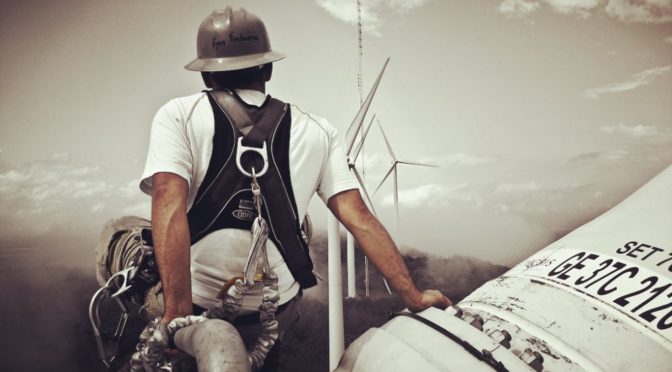Modern wind turbines are marvels of engineering innovation. Optimizing the capture of wind energy requires placing spinning blades high in the air, where wind variability—or turbulence—is minimalized. The larger the turbine’s diameter, the more power it can produce.
A larger diameter typically means a taller tower. New wind facilities are installing towers that are 300 feet tall or more at the hub.
The anatomy of a wind turbine
The spinning blades of a
wind turbine are mounted to the hub of a turbine’s nacelle, an enclosure full of fine-tuned electromechanical equipment. In order to keep the turbine running at peak performance, the nacelle must be regularly accessed to conduct inspections, add lubricants, maintain the components, and replace worn parts.
Reaching the nacelle from the ground isn’t easy. Cranes with a sufficiently long boom lift usually aren’t available nor viable to move technicians up and down the wind turbines. Instead, crews need to climb the old fashioned way—one rung at a time.
Wind turbine towers are built in segments or sections. The height of each section varies according to the engineering requirements of the specific tower. A ladder goes up the inner wall, passing through hatches in decks provided at each section which serve as resting points when needed.
Even with the occasional rest point, climbing such a tall tower unassisted can be exhausting and dangerous. In the early days of wind energy, technicians tasked with working in the nacelle had to rely on their own strength to get them to the top.
Personnel lifts and climb assists make the climb much safer
Today’s process is much safer, thanks to the availability of personnel lifts and climb assist technology.
Personnel lifts are installed inside the tower and can be integrated with the existing ladder system or installed as a standalone unit. Lifts come in many different configurations that can accommodate multiple technicians or a single rider, depending on the tower design and lift specification.
Lifts generally are slower to ascend and descend a tower than a “free” climb or with climb assist, but can better facilitate technicians needing to climb multiple turbines per day while minimizing fatigue and burnout.
At facilities where Pattern’s own wind technicians manage operations and at certain of our new construction sites, Pattern has begun to install personnel lifts that allow for one climber at a time to safely ascend and descend the tower.
Technicians are required to wear full fall-arrest and climbing gear while using the lifts. In the event of a malfunction of the lift, the lift will stop in place, and the rider will connect to the ladder system, disembark, and safely finish the climb. We are excited to continue to expand the use of lifts in our operating fleet!
Climb assists are an alternative to personnel lifts. A climb assist is a sophisticated pulley system integrated into the ladder structure of the turbine. A motor installed at the tower’s base places tension on a cable loop running to a pulley, or sheave, at the top of the ladder. The motor provides enough lift to take 40-60% of the climber’s weight, and in many cases the climb assist can be tuned to the climber’s weight to ensure appropriate ascend and descent rates. The climber—not the motor—determines the speed of the climb.
The climber using a climb assist wears a step-in harness that goes around the waist and each leg, as well as over the shoulders. The harness includes integrated high-durability D-rings at strategic points. A specialized D-ring at the sternum is attached to the climb assist cable. In the event a climber begins to fall, the separate fall arrest system will engage and safely arrest the fall so the climber can get back under control.
“Lifts and climb assists are an important part of our turbine safety toolbox at Pattern,” says Vice President of Field Operations Ryan Pierce. “Preventing falls and reducing fatigue is one of their important roles, but day-to-day they also prevent wear and tear on the technicians. Over time this makes a big difference in the wellbeing and even longevity of a technician’s career in working on turbines.”
No substitute for training
Pattern’s commitment to safety goes well beyond relying on technology alone. Wind technicians undergo extensive training and retraining throughout their careers to ensure they are equipped with knowledge, the right tools, and proper safety gear.
“Safe climbing practices are a point of emphasis in our safety program,” Pierce says. “Technicians need to know how to inspect the lifts and climb assist equipment for defects, and what to do in the rare event of an equipment failure.
Simply said, climbing doesn’t happen until all training requirements are met.”
Lifts and climb assists operated by knowledgeable wind technicians significantly reduce the risk of injury. Deploying these technologies is one of the important ways Pattern protects the health and wellbeing of the people who keep the turbines spinning and the lights on across North America.

